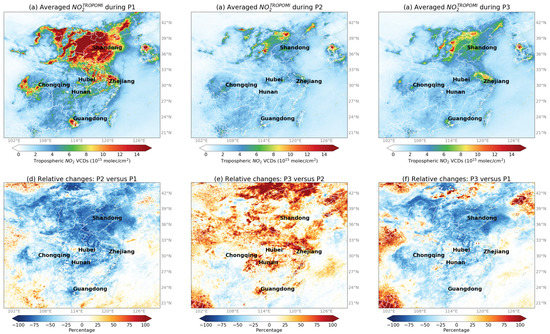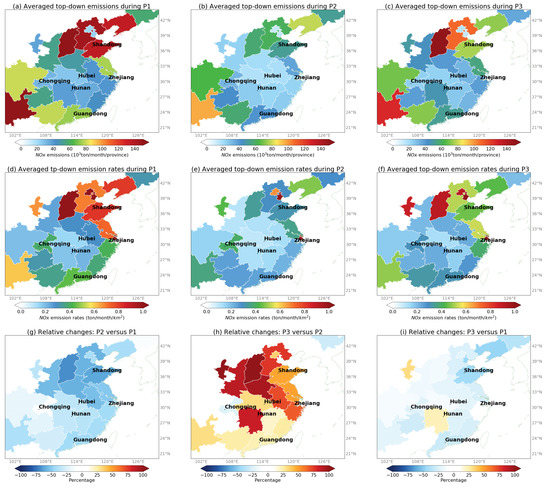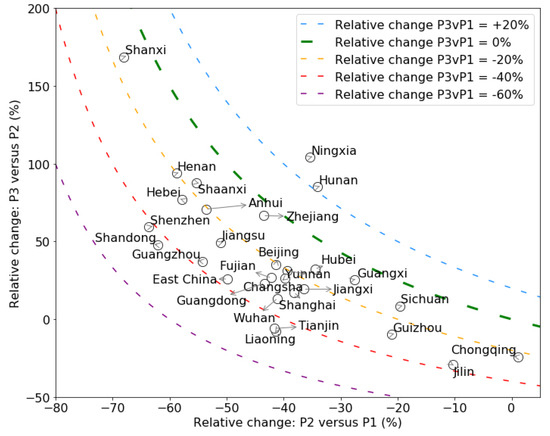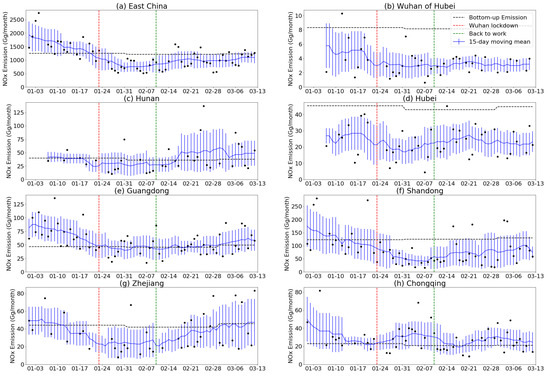The daily top-down emissions at regional levels are subject to large day-to-day variations, which may result from real signals, random error, or uncertainties. To better illustrate the changes of top-down emissions, we grouped the data into three periods: P1 (January 1st to January 23rd, 2020), P2 (January 24th to February 9th, 2020), and P3 (February 10th to March 12th, 2020). Note that our conclusions are not sensitive to small changes in the selection of the periods. We presented the analysis of period-averaged data in
Section 3.1 and
Section 3.2. We also investigated on the time series of top-down NOx emissions in typical regions in
Section 3.3. The complete data for each region, including NO
2TROPOMI, top-down emissions, and bottom-up emissions from MEIC, are included in
Table S1 (Table_S1.xlsx in the Supplementary Materials).
NO2TROPOMI Changes
shows the NO
2TROPOMI averaged during three periods and the relative changes between them. “P3 versus P1” means the relative change of NO
2TROPOMI between P3 and P1. It is clear that NO
2TROPOMI decreased greatly in P2 relative to P1, and there is a limited recovery during P3, in accordance with a previous report [
19]. The levels of NO
2TROPOMI can be controlled by many factors, including anthropogenic NOx emissions, meteorology (such as sunlight, precipitation, advection, and convection), and other pollution emissions.
Figure 1. (a–c) TROPOMI tropospheric NO2 VCDs (NO2TROPOMI) averaged during the three periods. (d–f) Relative changes between periods.
shows the NO
2TROPOMI changes in eight selected regions, which would be discussed in more detail in
Section 3.3. Overall, in East China, the NO
2TROPOMI decreased by 52% from P1 to P2 and increased by 19% from P2 to P3. The averaged NO
2TROPOMI increase of 0.3 × 10
15 molecules/cm
2 from P2 to P3 only recovered 14% of the NO
2TROPOMI decrease from P1 to P2 (2.1 × 10
15 molecules/cm
2).
Table 1. Averages and standard deviations (temporal variability) of NO2TROPOMI during three periods and the relative changes between the three periods.
Top-Down NOx Emission Changes
The top-down NOx emissions (as derived in
Section 2.3) averaged during the three periods and the relative changes between them are shown in and . The top-down NOx emission for East China was estimated as 1589.3 ± 449.8 Gg/month during P1, compared to 1250.6 Gg/month estimated by the bottom-up emission inventory (MEIC). Because the focus of this research is on the relative changes of top-down emissions, the differences between top-down and bottom-up emissions are not discussed. NOx emissions decreased from P1 to P2 (g) and increased from P2 to P3 (h) in almost all regions in East China, consistent with emissions being the main driver of NO
2TROPOMI changes during the periods. Overall, in East China, NOx emissions decreased by 50% from P1 to P2 and increased by 26% from P2 to P3. As a result, the NOx emissions during P3 were still 37% lower than the ones during P1. NOx emissions only recovered 206 Gg/month from P1 to P3, which was 26% of the emission decrease (794 Gg/month) from P1 to P2 (i). Hereafter, an emission recovery refers to regain the emission decrease from P1 to P2 (i.e., P2-P1) in P3.
Figure 2. (a–c) Top-down NOx emissions summed up in each province during the three periods. (d–f) Top-down NOx emission rates (emission per area) of each province during the three periods. (g–i) Relative changes of top-down emissions between the periods.
Table 2. Averages and standard deviations (temporal variability) of top-down NOx emissions during the three periods and the relative changes between the three periods.
The top-down NOx emissions decreased most in North China and Central China (e.g., Shandong) during P2 versus P1, while those in Southwest China (e.g., Chongqing) merely changed (,
Table S1).
Although top-down NOx emissions changes (P2vP1: −50%, P3vP2: 26%) were very close to NO2TROPOMI changes (P2vP1: −52%, P3vP2:19%) in East China, the discrepancies between the two were evident at the provincial level. Between P1 and P2, in Jilin, Chongqing, Yunnan, and Sichuan, the relative changes of NO2TROPOMI were −54%, −30%, −2%, and −35%, respectively, and those of top-down NOx emissions were −10%, 1%, −39%, and −20%, respectively. Between P2 and P3 in Shandong, Zhejiang, and Hunan, the relative changes of NO2TROPOMI were 26%, 38%, and 33%, respectively, and these of top-down NOx emissions were 48%, 67%, and 85%, respectively.
This implies that the recovery of human activity and subsequent anthropogenic emissions was much faster than what is implied by the NO2TROPOMI in these regions. NO2TROPOMI changes are dependent on both NOx emission changes and meteorological changes. For example, it is likely that increasing precipitation, higher temperature, and stronger sunlight would shorten NOx lifetime and decrease NO2TROPOMI after February, given fixed NOx emissions. Assuming that WRF-GC reasonably captured the meteorological impact on NO2, NO2WRF-GC can serve as a baseline which shows how tropospheric NO2 VCDs should have behaved with changing meteorology but fixed emissions. The top-down NOx emissions, which were derived partly based on NO2WRF-GC, were largely independent of meteorological factors. Still, the top-down NOx emissions were subject to the uncertainties of both WRF-GC, TROPOMI retrievals, and bottom-up emissions. However, as this research focuses on the relative changes of top-down NOx emissions, as long as there is no systematic bias of temporal changes of both WRF-GC simulation and TROPOMI retrievals, we consider the results presented here to be reasonable. In East China, where primary sources of NOx emissions are anthropogenic, the actual anthropogenic NOx emission changes can be better captured by top-down NOx emission changes. The changes of NO2TROPOMI can be significantly larger or smaller than the changes of NOx emission in individual regions. Therefore, one needs to be careful when attributing the changes of NO2TROPOMI solely to the changes of human activity.
better illustrates the top-down NOx emission changes in each region. The recovery rate can be measured by the relative changes of top-down emissions between P3 and P1, as shown by the colored contours. The contour of “relative change P3vP1 = 0%” means a full recovery from the emission decrease in P2. Most regions have decreased emissions between P1 and P2 and increased emissions between P2 and P3. Only Ningxia and Hunan have increased emissions in P3 compared to P1, while other regions have not fully recovered in P3.
Figure 3. Relative changes between the three periods of individual modeled region, represented by the annotated circles. Colored contours represent the relative changes between top-down emissions during P3 vs these during P1.
Timeseries in Selected Regions
To better understand the different emission reduction and recovery patterns, we examined the timeseries of daily regional top-down emissions of the eight selected regions in . These regions serve as good examples of different emission change patterns. As the daily top-down NOx emissions have high day-to-day fluctuations, we also presented 14-day central moving averages in to better reflect the general trends. We included similar time-series of all regions, for more information see the
Supplementary Materials. For readers’ references, we included several reference lines: the monthly emissions from the MEIC emission inventories, the dates for Wuhan lockdown, and official nationwide back-to-work day. The MEIC emissions serve as references on how the emissions should change temporally.
Figure 4. (a–h) Daily top-down emissions (black dots) in different regions. The horizontal black dash lines represent bottom-up emissions (MEIC) to show the a priori knowledge of the month-to-month variation of NOx emissions. The blue solid line represents 15-day center moving averages of daily top-down emissions, and the error bars represent corresponding standard deviations of the data in the 15-day window. Vertical red and green dashed lines represent the dates of Wuhan lockdown and official back-to-work day.
East China: Recovering
The top-down NOx emissions decreased before the Wuhan lockdown, reached their lowest point after the Chinese New Year (January 24 to February 2), and then gradually increased afterwards (a). Assuming that the NOx emissions keep increasing at current rate, it would still take a few months for the emissions to return to their levels back in January.
Wuhan of Hubei: No Sign of Recovering
Being the first epicenter of COVID-19, NOx emissions decreased in Wuhan (b) before the lockdown and there was no sign of recovering by March 12. In fact, non-essential businesses were only allowed to return to work after March 20th [
5]. Although shows there was a possible 13% increase from P2 to P3, the
p-value from an ANOVA test is 0.41 (ANOVA:
p = 0.41), meaning that the difference between the P2 and P3 periods was not significant at all. This suggests a similar lockdown state of Wuhan when businesses were limitedly functioning from January 24 to March 12.
Wuhan, however, was not the only region without a successful recovery. shows that Liaoning and Tianjin suffered from similar emission reductions (−41%, ANOVA: p = 0.01; −42%, ANOVA: p = 0.01) from P1 to P2 and the emissions stayed about the same from P2 to P3 (−8%, ANOVA: p = 0.73; −6%, ANOVA-p = 0.79). While businesses in Tianjin and Liaoning were ordered to return to work after February 10, they seem to need more time to recover.
Hubei and Hunan: Possibly Recovered
Wuhan is the capital of Hubei, and Hunan is adjacent to Hubei and generally very close to Wuhan. However, they shared a quite different emission pattern compared to Wuhan. Hubei (d) and Hunan (c) both have decreased NOx emissions from P1 to P2 by 34%; they featured NOx emission increases of 32% and 85% from P2 to P3, respectively. Considering the staggering NOx emission in Wuhan, the NOx emission increase was even larger in Hubei excluding Wuhan. As a result, the top-down NOx emissions in Hubei and Hunan during P3 had no significant difference compared to these during P1 (ANOVA: p = 0.32 and 0.5).
Guangdong and Shandong: Recovering Slowly
NOx emissions in many more developed and industrialized provinces greatly decreased prior to P3. Among them, we chose to use Shandong (f) in North China and Guangdong (e) in South China as examples. Similar to the pattern of East China, Shandong and Guangdong had NOx emission decreases of −62% and −43% from P1 to P2 (ANOVA:
p = 0.00 and 0.00). The NOx emissions gradually increased (48% ANOVA:
p = 0.10; 23%, ANOVA:
p = 0.13) after February 9 but they had not fully recovered before March 12 (e,f). Like Guangdong and Shandong, most other provinces followed this similar pattern, such as Jiangsu, Fujian, Guizhou, Beijing, Shanghai, and Shenzhen (
Table S1 in the Supplementary Materials).
Zhejiang: Almost Recovered
The top-down NOx emissions of Zhejiang decreased by 44% from P1 to P2 but increased by 67% from P2 to P3 (). As a result, the difference between P3 and P1 was not significant (−6%, ANOVA:
p = 0.77). Zhejiang was the first province to declare a highest level response to coronavirus on January 23 and the first province to urge its local governments to relax control measures and support business resumption [
38]. Zhenhai of Zhejiang has nearly 200 chemical plants including the largest oil refinery in China [
39]. Zhejiang is also known for its thriving private sector, which constitutes 65.5% of the total gross domestic product (GDP) in the province in 2018 [
40]. It is possible that both the efficient order execution of local governments and the rising pressure to resume work of private sectors resulted in the faster recovery of business activity and NOx emissions.
Besides, Zhejiang, Shanxi, Shaanxi, Guangxi, and Beijing also recovered fast with no significant difference between P1 and P3 (ANOVA:
p = 0.55, 0.38, 0.49, 0.31, respectively). Among these, top-down emissions of Shanxi rebounded with the most rate, the emissions decreased by 68% (ANOVA:
p = 0.00) from P1 to P2 and increased by 169% (ANOVA:
p = 0.01) from P2 to P3. There are several possible reasons why the NOx emissions in Shanxi increased fast. Shanxi was one of the provinces with fewest confirmed cases (138 cases as of April 7th, 2020) [
41]. Moreover, MEIC emission inventory indicates that 31% and 26% of total NOx emissions came from powerplants in Shanxi and Shaanxi, respectively (
Table S1), which were much higher than the averaged percentage in East China (19%).
Chongqing: No Significant Changes
Surprisingly, there are a few regions not showing significant changes of NOx emissions from P1 to P2. Chongqing (h) had no significant change of top-down NOx emissions from P1 to P2 (1%, ANOVA-p = 0.96). Jilin was also barely affected from P1 to P2 (−10%, ANOVA-p = 0.71). The reason why these regions were hardly impacted during COVID-19 is yet to be investigated.




